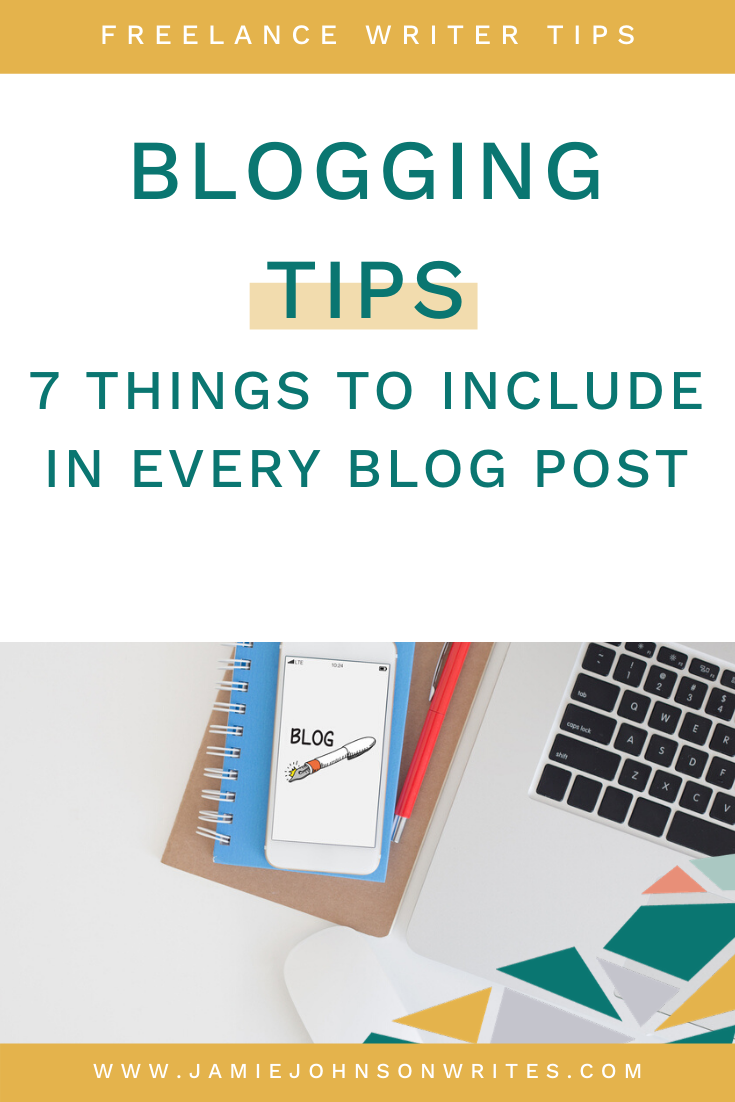How to Write a Blog Post: 7 Things You Need to Include
True story: when I first started freelancing in 2016, I had never even heard the term “content marketing.” I didn’t know how to correctly format a blog post. I had no clue how to make my blog posts engaging or come up with a good title.
Little by little, I learned all these things over the years, mostly through trial and error. And I knew I needed to put together some type of checklist I could run through before I hit “publish” on every post.
This helps me ensure that I’m providing the most value to my clients and giving them the best chance to show up in Google search results.
7 Things to Include in Every Blog Post
So without further ado, here are seven things you should include in every blog post:
1. An engaging title
Your title is arguably one of the most important factors in determining whether or not people read your blog post. If you choose a weak title, most people won’t read it no matter how great the content in the post itself is.
In order to come up with a great title, you should include two things:
A long-tail keyword (more about this later!)
Specificity
When you add a long-tail keyword, you’re optimizing your blog post for search engines. And by being specific, you let people know what they can expect to get out of your blog post and persuade them to read it.
Example of a weak headline: “Things I Learned About Freelancing” -- boring and kind of generic.
Example of a catchy headline: “5 Things You Need to Know About Becoming a Freelance Writer” -- specific, includes a keyword, lets the reader know what to expect.
Pro tip: One of my favorite blogging tools is the CoSchedule Headline Analyzer. It’s free to use and it analyzes your headline for word balance, SEO-optimization, and length.
2. Short, skimmable paragraphs
One thing that always makes me cringe is when I click on a blog post only to find that it is just one huge wall of text. Not only is it hard to read but it just looks bad.
When most people click on a blog, they’re looking for something specific. There’s some kind of question they want to be answered, and they want to find it as quickly as possible.
Most people will quickly skim your blog posts, and look for only the most useful info. So if it’s not easy to find, most readers will bounce. So make sure all of your paragraphs are short and easy to read.
Pro tip: The average visitor will only read 25% of your article so make sure your articles include lots of short, skimmable paragraphs. I recommend only using one to three sentences per paragraph.
3. Lots of subheadings and bullet points
To piggyback off my previous point, a great way to make your content skimmable is by including lots of subheadings and bullet points. This is a great way to break up your article and make it more visually appealing. And subheadings are a great way to incorporate keywords into your blog post.
4. Simple, conversational language
Okay, this is one that I have to work on frequently myself as I have a tendency to write long, overly complicated sentences. While that may be something that other writers can appreciate, this won’t be the case for most people.
So avoid using complex phrases and complicated jargon in your writing. Just talk to your readers like they are a friend and keep it simple.
Pro tip: Purchase the Hemingway Editor -- it will review your writing for things like the passive voice and sentences that are difficult to read. It will also give you a grade for readability; personally, I aim for about a seventh-grade readability for all my blog posts.
5. Internal and external links
It’s always a good idea to include internal and external links in every blog post. However, not all external links are created equal. Only include links to high authority websites.
If you use spammy or low authority links it can hurt your ranking in Google. And internal links are great because:
It is helpful to your audience and allows them to learn more about a particular subject.
It incentivizes your readers to spend more time on your website.
Pro tip: Include at least one external and internal link in every blog post.
6. SEO-optimization
Every time you begin a new blog post, you should choose a long-tail keyword to use several times in that post. A long-tail keyword is several words or a short phrase that your audience might search for in Google.
Long-tail keywords are better because they are more specific and easier to rank for than a generic word or phrase. For instance, if you are writing a blog post on how to get started blogging, “starting a blog” will be easier to rank for than just “blogging.”
Pro tip: Consider using Ubersuggest, a free keyword tool from Neil Patel, master of all things content marketing. This will help you research long-tail keywords and tell you which keywords have the lowest competition.
And if you use Wordpress, you should definitely download the Yoast SEO plugin. This plugin makes it so easy to ensure every blog post is SEO-optimized.
7. A CTA
Ultimately, freelance writing is about selling products and services. Your clients hired you because they’re trying to market themselves through content marketing.
So at the end of every blog post, it’s a good idea to encourage readers to take some kind of action. This is known as a call-to-action (CTA).
Of course, this always depends on your clients and what they’re looking for. I have some clients that don’t want me to include a CTA because they think it sounds too salesy. Then I have other clients who would be annoyed if I didn’t include one.
Pro tip: Always stay focused on your client and what you can do to create the best blog post possible for them. I promise you that they’ll love you for it!



